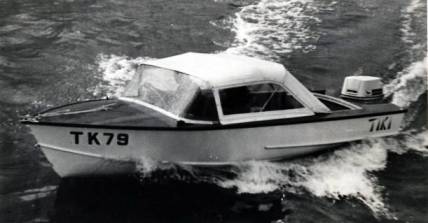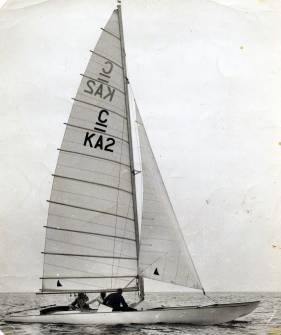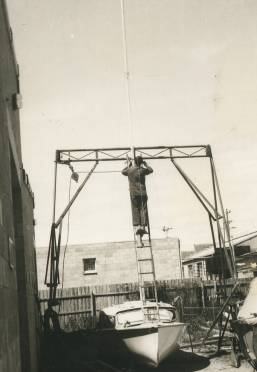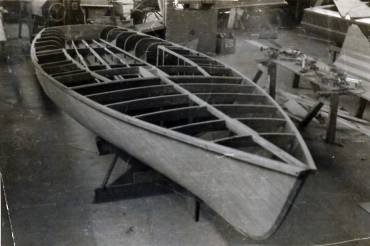There was a new magic word being talked about in boating circles it was "FIBREGLASS". No one had seen it, or used it in Australia, but most had a story about it. It was as strong as steel! - It was a myth - you can't build boats out of glass! - Fire a gun at it, and the bullet will bounce off!- and so the stories went.
All boat builders in Melbourne were invited to see a film called "The Magic Marble" at the offices of A.C.I. and this American film showed glass marbles being melted, and formed in to very fine strands of glass to form a matt, or continuous rovings like string.
I guess that everyone at that film was like me, and couldn't wait to get hold of a sample to try it out. A Polyester resin was available, and we were given some samples of continuous rovings. The rovings didn't look like they were very strong, and the resin was very smelly.
That night when I got home I tried out this miracle stuff. I cut the rovings in to short strips and laid them in a random fashion in one of Mum's saucers, mixed the resin as per instructions and poured it into the saucer. The instructions had said, "The laminate may need to have heat applied to make it cure", so when my mother had finished with the oven after dinner I slipped the saucer in and closed the oven door (wood fired ovens kept their heat for hours). The next morning there was a terrible smell in the kitchen, and when I took the saucer out there was still just a sticky mess. The resin hadn't cured. Strange. It seemed that every one that had tried the samples had the same trouble. I forgot about that hopeless stuff for quite a time until I was told that the resin we were given really needed an accelerator mixed in first. Anyway I had lost interest by now, and the smelly stuff was banned from anywhere near the house.
Some months after this an advertisement appeared in the paper for fibreglass dinghies and stated that a demonstration would be given the following Saturday at the Sorrento pier.
I gave up my sailing for the day and went down to Sorrento to see this magical boat that bullets would bounce off. When I got there, the builder was well into his spiel about how strong the boat was. "I could even jump in to the boat off the jetty and it wouldn't hurt it". One of the group of onlookers suggested he tried it. And he did! Fortunately the water there was still shallow a long way out, and the unfortunate gentleman with his right leg protruding thru the bottom of the boat was carried up to the beach. There was a lot of blood, and his leg wouldn't come out without breaking off the protruding pieces of the boat's bottom.
It was another ten years before I became interested in that terrible stuff again!

The 14 ft runabouts became very popular, and we built several hundred of them.
This one we kept for many years and it was even raced. (The reg number was a coincidence).
It was called Tiki because it had a Teak deck.
Certain New Zealanders thought we were one of them, and sent us little Tiki carvings!
Five years had passed at Somerville and we had a staff of six. We had been building dinghies, 8, 10, and 12ft long. We had built 40 fourteen footers, and they were sailing in four states. There was a big demand for small ski boats. I had designed a 14 foot and an 18 ft runabout, but we were too busy to start them yet.
I had a visitor - he didn't want a boat - but said he had a proposition for me. He had sailed, but now was mainly interested in fishing.
Would I be interested in a partnership? He owned a block of industrial land in Frankston, and was prepared to build a factory, and also to put in a fair amount of cash if I was interested.
George Dettmer was a nice easy going sort of chap, and we did come to an agreement. We had really out grown where we were. It was difficult to get to, and I had the feeling that Dad wanted his farm back without all the disruptions that we caused. There were just two other conditions that I wanted; I would keep the patent in my name, and that in the factory George was to build an electric oven that would take up to twenty five feet long mouldings. Everything was agreed to, and the move was made to Frankston.

The C class cat Matilda was built to challenge for the Little America's Cup
in England and was designed by a Professor of Hydraulics at the Melbourne University.
The hulls were three layers of 1/16 Balsa and sheathed. The 25 ft hulls weighed
40lb each. She was beaten by the English boat, and because of the extreme spring
in the keel and very light weight, it did hobbyhorse in choppy conditions.
At last I now had enough money to buy my first car, and was looking at second hand Holdens (Holden cars had started production in Australia in 1948, and cost around seven hundred pounds new) .The nearest dealer was just outside the Frankston station, and when I enquired the salesman suggested that I forget Holdens if I was interested in towing a boat. He had a couple second-hand - one had a tow bar, and the back doors wouldn't close properly. "The dammed cars don't have a chassis and they stretch if you tow with them." I ended up paying forty nine pounds for a second hand Vanguard!
We started off in the new factory with a staff of ten and an office girl. Everything seemed to be happening at once now, and I am having trouble putting things in order.
We were asked to tender for the building of the "Finns" for the forthcoming 1956 Melbourne Olympics. We had a set of plans and specifications and the tender documents, and went to a lot of trouble with our costing to make sure that we tendered a competitive price, although being the only builders in moulded ply construction, we were confident of winning the contract. It did seem strange that the winning tender was just five pounds less per boat than ours, and that J. Savage and sons had never attempted to build a boat in moulded ply. Even stranger was that the following week we had a phone call from a member of the selection committee requesting that we help by advising the winning tenderer on how to go about moulding the boats. I did not reply, nor did I enquire as to what method was used in their boats construction, as we had more work than we could handle anyway.

Photo taken 1954. our first attempt at marketing
a trailable sailing boat with accommodation.
One of the boats that I designed then was a 16 ft trailable sailing boat with a cabin and two berths, but there wasn't much interest and only two were sold, one ended up just a fishing boat.
It seems strange now that I never did own a camera, and never did attempt to record any of the things we did. Many years later my mother gave me an album with all the newspaper cuttings that she had kept, and the photos that I use now were either given to me by clients or were used by boating magazines. Later my wife, June, accumulated a dozen albums of our boats. But the first ten years were never recorded.
I sailed in the Finn elimination heats for the Melbourne Olympics amid a lot of controversy and in one of the final series got in to trouble. It happened like this: A good hard southerly was blowing, and a nasty sea was running. It was only seconds to a start and a boat that was too early for the start came running down the line on a wave straight at me. We were both on starboard tack, and he had intended to go behind but broached instead right on top of me, and his boom caught me right on the ear, I could see it coming, but couldn't do much about it as I had my main hard on, and sliding to leeward would have meant a capsize, and too late to ease the main. I ended up in the cockpit on the floor with blood every where and barely conscious. To his credit he escorted me in to the beach and unrigged the boat while I was being patched up.
At this point of the story I just don't quite know which way to go. Over the last six years more progress had been made in boating than in the previous hundred, Fico and Rostan had revolutionised the manufacture of fittings using stainless steel, sails were now being made in synthetics, wire rigging had gone from hand spliced galvanised wire to swaged stainless, spars were now mainly aluminium, and the new synthetic ropes were a joy to handle. Boats were half the weight of those built ten years previously, so boats on trailers were becoming a common sight.

Photo shows the deck framing of my boat "Wasp", The deck beams
were only 3/16 ply, and the complete 20 ft hull weighed only 140 lbs,
when the boat was rigged, two of us could lift it off the trailer and
in to the water.
A lot of the older popular one design sailing classes were fast disappearing, but newer and larger trailable boats were taking their place. We were building Flying Dutchmen, 505s, Flying fifteens, Jolly boats, Port Phillip twelves, Kitty Cats, 16 ft skiffs, Moths, and were working on a very special Catamaran.
Flying Dutchmen had become a very popular class and were to take over from the now outdated heavy weight 12sq metre Sharpie in future Olympics. We had already built twenty, and we really should have a promotion boat ourselves. Anyway, that was the excuse I used!
The Flying Dutchmen was a strict one design, with tolerances of only + or - 5mm, although the deck layout was optional and I was keen to try something different. In our conditions these boats were a bit of a handful, and the helmsman needed to use his weight to best advantage, especially when the forward hand had to come off the trapeze to set a spinnaker. That is why we tried a rolled-in edge at the aft edge of the cockpit.